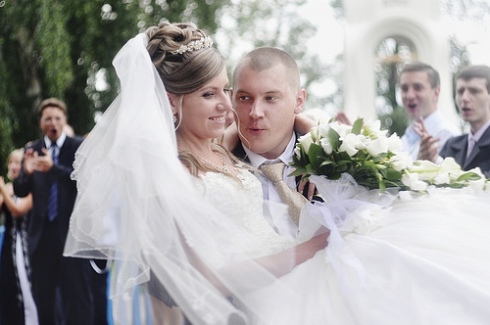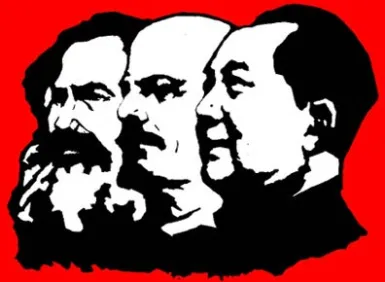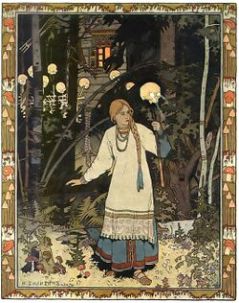As with much of Russian culture, the wedding celebration is full of traditions. The traditional Russian wedding lasts for at least two days, but sometimes lasts as long as a week.
Wedding Dress
The bride never wears her dress or shoes before the day of the wedding, to ensure her happiness.
Ceremony traditions
One tradition that seemed to be present in some form in every source that I read was the tradition of the groom paying “ransom” for his bride before he can marry her (known as the вы́куп неве́сты). Apparently, the family of the bride “steals” the bride and hides her before the ceremony and refuses to return her until the groom has presented money or jewelry in exchange for her return. Sometimes, they will dress a cousin of the bride (occasionally male for more comedy) up in white and cover his/her face with a veil and present him/her to the groom after he has made the first “payment.” After he has realized that the cousin is not his bride, he has to make a second payment in order for his real bride to be returned to him. Another version that I found said that the groom is presented with a napkin with the lipstick prints of all of the bride’s family, including the bride herself. If he can’t correctly identify his bride’s kiss, then he pays tribute. One form of this is said to be covering a shall with rubles in payment.
Of course, the ceremony differs depending on the religion of the bride and groom. As in American culture, a church ceremony is not necessary for a legal union, only a civil service. However, if the couple is married in the orthodox church, the proceedings are ripe with tradition and ceremony. There are two parts to a traditional Russian Orthodox ceremony (called the venchanie): the betrothal and the crowning. The betrothal was at one point blessed at the beginning of the engagement, but it is now done in the same ceremony as the wedding itself. During the betrothal, the couple stands in the entrance to the church while the priest blesses them and gives them lit candles which they hold throughout the ceremony. The betrothal is then blessed by a prayer and scripture readings. Because the wedding is considered one of the seven sacraments in Russian orthodoxy and the sacraments are holy, the placing of crowns on the couples’ heads is more traditional than the trading of the wedding rings; hence the name of the second part of the ceremony, the crowning. The priest leads the couple to stand on a new piece of rose colored cloth, symbolizing the entrance into their new life together. The couple then each declares that they are marrying each other freely and are not promised to anyone else. The priest then places crowns on the heads of the bride and groom, where they are held in place by friends and family of the couple. After prayer and the sharing of a cup of wine by the bride and groom, the priest leads the couple three times around a lectern on which the gospel book has been set. This symbolizes the pilgrimage of wedded life. During this procession, the couple holds hands and the priest wraps his stole around their entwined hands. After more prayer, the priest announces the union of the couple and says the benediction. The tradition apparently used to be that the couple would wear the crowns for eight days following the ceremony, but now they are taking off after the benediction.
The civil ceremony takes place after or in place of the traditional ceremony. It lasts for about 15-30 minutes. This is when the exchanging of rings occurs. During or right after this ceremony, the parents offer the couple two crystal classes, which they then break. The more shards of crystal they produce, the more years they will remain married. It is also traditional for the bride to release a balloon with her maiden name written on it, as she begins her new life with her new name.
Reception traditions
Before the reception even begins, it is traditional for the bride and groom along with their attendants tours the city to visit places of historical significance and take pictures there. I found some examples of what those locations would be for a couple getting married in St. Petersburg:
- The eternal flame of the heroes of World War II and the Bronze Horseman statue and monument to Peter the Great dominating Senate Square.
- To the sphinx embankment on Peter Vassilevsky Island to pet the 4,000-year-old Egyptian statues and stone griffins for luck.
- To the Rostrum Column, decorated with ship prows and surrounded by an iron-link railing. Pictures taken the couple holding hands through the links symbolizes their bond
- The Peter and Paul Cathedral. Russian couples toast with champagne and then smash their glasses against the fountain near the cathedral.
- To the New Hermitage Portico along the city’s Millionaires’ Row, where giant marble Atlanti statues act as columns. Russian brides rub the toes of the statues for luck.
The actual reception sometimes begins on the second day of the wedding celebration. Glasses and silverware are not placed on the tables for the reception. The guests must pay for them, to help the bride and groom get started in their life together. The bride must “clean the floor” also, which means that she scoops up money that the guests have dropped. A third tradition involving money is that the guests drop coins into the bride and grooms’ glasses of champagne, contributing to their future prosperity.
Another reception tradition is the breaking of a plate, similar to that that exists in Greek culture. The difference is that the bride and groom then jump over the shards, symbolizing their passing into the future.
The Fire Toast: a shot of vodka toast made to the newlyweds. The guests then shout “Gorko, Gorko . . .!”
meaning “bitter”. The couple must then kiss for a long time to get rid of the bitter taste of the vodka. The second toasts is made to the parents of the bride and groom.
http://masterrussian.com/russianculture/russian_wedding.htm
http://en.wikipedia.org/wiki/Russian_wedding_traditions




